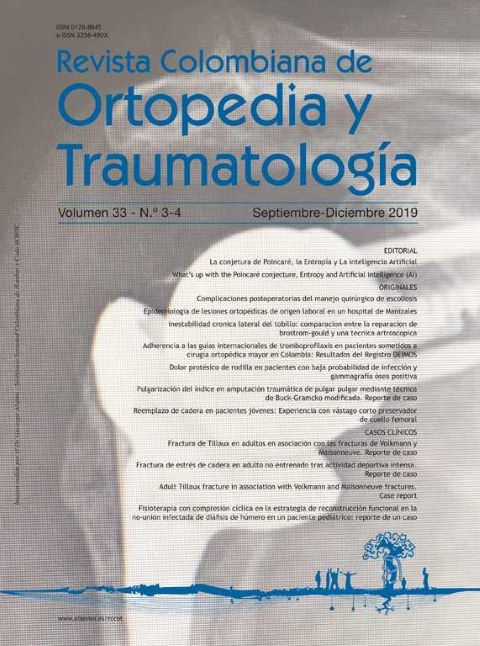Chronic Lateral Ankle Instability: Comparison Between Brostrom-Gould Repair And An Arthroscopic Technique
DOI:
https://doi.org/10.1016/j.rccot.2020.02.008Keywords:
ankle ligaments, chronic instability, anterior talofibular ligament, Broström-Gould, arthroscopic repairAbstract
Background: Chronic lateral ankle instability is a common condition in people with inversion sprains. Initial treatment is conservative, and if that does not work a surgical approach is recommended, such as that described by Broström and later modified by Gould, and is the most used and effective. With the advent of arthroscopic surgery, one of the authors (JBGG) has recently developed a minimally invasive technique that has been used in the Surgical Foot and Ankle Unit of Imbanaco Medical Centre for 8 years. Therefore, this work aims to determine functional outcomes of patients treated with the arthroscopic technique compared with the open technique of Broström-Gould.
Methods: A total of 111 patients were evaluated, including 50 with the open method, and 61 with arthroscopic surgery technique for chronic lateral ankle instability between January 2004 and December 2011. The American orthopaedic foot and ankle score (AOFAS) scale for ankle and hindfoot was used for measuring pain, function, and alignment, and a visual analogue scale (VAS) was used to assess the pain.
Results: The final AOFAS score was 90 points, and instability was reversed in 96% of cases, for both groups of patients. The pain was relieved efficiently by both techniques. There were no statistically significant differences between the study groups.
Discussion: Arthroscopic repair of chronic lateral ankle instability is an effective tool to restore the function and stability, as well as eliminate ankle pain, and is comparable in effectiveness with the conventional technique. Additionally, there is a lower chance of complications related to wounds.
Evidence Level: III
Downloads
References
DiGiovanni CW, Brodsky A. Current Concepts: Lateral Ankle Instability. Foot & Ankle International. 2006;27:854-66. https://doi.org/10.1177/107110070602701019
Ventura A, Terzaghi C. Arthroscopic Four Step Treatment for Chronic Ankle Instability. Foot & Ankle International. 2012;33:29-36, 10.3113/FAI. 2012.0029. https://doi.org/10.3113/FAI.2012.0029
Gerstner Garces JB. Chronic Ankle Instability. Foot and Ankle Clinics of North America. 2012;17:389-98, https://doi.org/10.1016/j.fcl.2012.06.001
Hubbard TJ, Kramer LC. Contributing Factors to Chronic Ankle Instability. Foot & Ankle International. 2007;28:343-54. https://doi.org/10.3113/FAI.2007.0343
Coughlin Michael J; Mann Roger A. Surgery of the Foot and Ankle. Mosby Elsevier, 2007/Volume II: 1451-1470.
Kapandji A. Fisiología Articular. Editorial Panamericana, 1998/Volumen II Miembro Inferior:158-175.
Amendola Ned, Stone, James W. AANA Advanced Arthroscopy of the Foot and Ankle. Saunders Elsevier. 2010:78-87.
Richie DH. Functional Instability of the Ankle and the Role of Neuromuscular Control: a comprehensive review. J Foot Ankle Surg. 2001;40:240-51. https://doi.org/10.1016/S1067-2516(01)80025-9
Keller M, Grossman J. Lateral Ankle Instability and BroströmGould Procedure. J Foot Ankle Surg. 1996;35:513-20. https://doi.org/10.1016/S1067-2516(96)80123-2
Ferkel RD, Chams RN. Chronic Lateral Instability: Arthroscopic Findings and Long-Term Results. Foot Ankle Int. 2007;28:24-31. https://doi.org/10.3113/FAI.2007.0005





